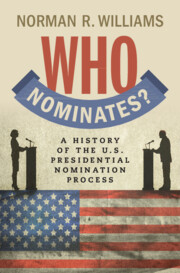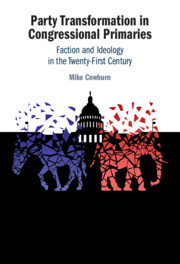Refine search
Actions for selected content:
28 results
5 - Catholics
- from Part II - Religious Traditions
-
- Book:
- Civil Religion and the Renewal of American Politics
- Published online:
- 09 October 2025
- Print publication:
- 23 October 2025, pp 79-103
-
- Chapter
- Export citation
8 - A Roadmap for Revolutionary Change
-
- Book:
- People v. The Court
- Published online:
- 07 August 2025
- Print publication:
- 21 August 2025, pp 179-194
-
- Chapter
- Export citation
3 - The State Convention and Party Bosses, 1836–1964
-
- Book:
- Who Nominates?
- Published online:
- 28 June 2025
- Print publication:
- 17 July 2025, pp 51-80
-
- Chapter
- Export citation

Who Nominates?
- A History of the U.S. Presidential Nomination Process
-
- Published online:
- 28 June 2025
- Print publication:
- 17 July 2025
Democratic Policymakers’ Ambiguous Support for Reparations: Implications for the Policymaking Process
-
- Journal:
- Journal of Race, Ethnicity and Politics / Volume 10 / Issue 2 / July 2025
- Published online by Cambridge University Press:
- 19 December 2024, pp. 396-425
-
- Article
-
- You have access
- Open access
- HTML
- Export citation

Party Transformation in Congressional Primaries
- Faction and Ideology in the Twenty-First Century
-
- Published online:
- 09 November 2024
- Print publication:
- 14 November 2024
3 - “Hope and Change” Meets “Make America Great Again”
-
- Book:
- Polarized by Degrees
- Published online:
- 05 September 2024
- Print publication:
- 05 September 2024, pp 76-120
-
- Chapter
- Export citation
Black Millennials, Slipping Alliances, and the Democratic Party
-
- Journal:
- Journal of Race, Ethnicity and Politics / Volume 9 / Issue 2 / July 2024
- Published online by Cambridge University Press:
- 11 January 2024, pp. 211-234
-
- Article
-
- You have access
- Open access
- HTML
- Export citation
7 - Parties, Factions, and Populism
-
- Book:
- Why Populism?
- Published online:
- 17 March 2023
- Print publication:
- 06 April 2023, pp 199-217
-
- Chapter
- Export citation
Chapter 13 - The New Social Cleavage
- from Part IV - A Faustian Bargain?
-
- Book:
- The Godless Crusade
- Published online:
- 23 March 2023
- Print publication:
- 30 March 2023, pp 195-207
-
- Chapter
- Export citation
Chapter 15 - A Faustian Bargain?
- from Part IV - A Faustian Bargain?
-
- Book:
- The Godless Crusade
- Published online:
- 23 March 2023
- Print publication:
- 30 March 2023, pp 225-248
-
- Chapter
- Export citation
2 - Federal Action on Domestic Violence
-
- Book:
- Inequality across State Lines
- Published online:
- 23 February 2023
- Print publication:
- 02 March 2023, pp 28-61
-
- Chapter
- Export citation
8 - The Trump Presidency, the Racial Realignment, and the Future of Constitutional Norms
-
-
- Book:
- Amending America's Unwritten Constitution
- Published online:
- 13 October 2022
- Print publication:
- 20 October 2022, pp 169-202
-
- Chapter
- Export citation
9 - The Struggle to Establish a Democracy since 1989
- from Part II - State and Nation Construction
-
- Book:
- A Concise History of Albania
- Published online:
- 18 October 2022
- Print publication:
- 29 September 2022, pp 323-377
-
- Chapter
- Export citation
7 - The Class Politics of Democratic Movements
- from Part III - Resistance
-
- Book:
- City on the Edge
- Published online:
- 19 April 2022
- Print publication:
- 19 May 2022, pp 151-171
-
- Chapter
- Export citation
11 - Polarization, the Administrative State, and Executive-Centered Partisanship
- from Part IV - Vicious Circles? The Relationship between Polarized Behavior and Institutions
-
-
- Book:
- Democratic Resilience
- Published online:
- 20 November 2021
- Print publication:
- 25 November 2021, pp 267-296
-
- Chapter
- Export citation
14 - The French Revolution and the Making of the American Democratic Party
- from Part II - The French Revolution Radicalizes Social Movements
-
- Book:
- Friends of Freedom
- Published online:
- 29 October 2021
- Print publication:
- 11 November 2021, pp 365-394
-
- Chapter
- Export citation
7 - Secularism and Party Politics
-
- Book:
- Secular Surge
- Published online:
- 14 January 2021
- Print publication:
- 03 December 2020, pp 138-151
-
- Chapter
- Export citation
8 - Secularism and the Democrats
-
- Book:
- Secular Surge
- Published online:
- 14 January 2021
- Print publication:
- 03 December 2020, pp 152-165
-
- Chapter
- Export citation
8 - The Compact and the Election of 1836
-
- Book:
- The Antebellum Origins of the Modern Constitution
- Published online:
- 16 October 2020
- Print publication:
- 29 October 2020, pp 187-213
-
- Chapter
- Export citation
